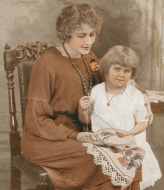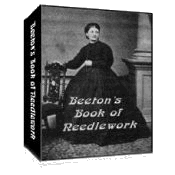Embroidery Instructions

Who needs embroidery instructions? How hard can it be? You just put some thread in a needle and stick the needle through the fabric until you have the design you want, right? I must admit, when I first considered learning embroidering, I thought, how hard can it be? Well, like any other art, learning to embroider properly takes time, patience, and practice. But don’t let that stop you from embroidering. It’s not hard. Once you learn a few stitches, you can make beautiful items!
Be warned though! You may become like me when you see a stitch you hadn't seen (or noticed) before and think … “Oh, look at that stitch! I like it. I’ve got to learn to make that and use it in my next project!” Yes, that happens to me all the time! Will it happen to you? Most probably! :-)
Do I still need embroidery instructions? You bet! I always seem to find something new when I read each and every article I find on the subject. Victorian ladies apparently felt the same. Embroidery instructions were abundant during the Victorian Age. They were in almost every woman’s magazine, paper, and book published during that time.
One of the most noted and copied articles of that era was written by Mrs. L. Barton Wilson, formerly Needlework Editor of the Ladies' Home Journal. Her work appeared in multiple magazines and was considered excellent advice.
Corticelli was the first to publish this article. Below is their introduction to this very thorough article.
For Beginners in Needlework
Corticelli Home Needlework, 1899
Edited by M. Schlueter
The engravings illustrating Part I of the article by Mrs. L. Barton Wilson on "The Theory and Method of Embroidery" were made from copyrighted photographs and show clearly the only right way to accomplish anything like perfection in needlework. Beginners must realize at the start that there is no "short cut" in embroidery. Study Mrs. Wilson’s article word for word. It is the most comprehensive treatise on the subject ever published. Mrs. Wilson is well known as an authority on Art Needlework, and her article, which she prepared especially for "Corticelli Home Needlework," will be found of the greatest benefit to beginners.
An Embroidery Frame or a Hoop Holder, with a seven, ten, or twelve inch embroidery hoop, is a necessity. Do not think you can "get along" without one or the other. Older and more experienced needleworkers have proved that it cannot be done. All these tools can be purchased at slight expense. Above all things resolve that whatever you do, you will do right.
When you have read and re-read " Equipment" and" How to Prepare for Work," study the following embroidery stitches until you feel you understand how to use them: The Simple Long and Short Stitch, Feather Stitch, sometimes called "Solid Embroidery," Kensington Outline Stitch, Simple French Knot, and Simple Buttonhole Stitch.
Leave all the others severely alone until you are familiar with the application of these stitches, when you should proceed with the Simple Satin Stitch , the Overlap Long and Short Stitch, and the Long and Short Buttonhole Stitch . Also notice the remarks referring to Figs. 12, 13, 14, and 15. (Note: These remarks are regarding using other stitches for flower stamens, particularly the wound stitches , figures 1 - 4.)
Beginners usually want to embroider double roses or some other equally difficult subject first. Don't attempt it. Choose a stamped linen of a simple design with few flowers, either a wild rose, or a buttercup. In embroidering flowers in which many colors are required, have a separate needle threaded for each shade; in fact, this is a good plan even if you are using only three or four shades.
No printed instructions can help you as much as a lesson, or better a course of lessons, under a good teacher. If this is not possible do not despair. The instructions herein are explicit and the illustrations accurate, and should be entirely sufficient to enable one to do good work.
Continue to "The Theory and Method of Embroidery", the article referenced above.
Other Embroidery Instructions
NOTE:The following embroidery instructions are NOT part of the article above; however, they do provide instructions on their subject.
If your embroidery project includes flowers, leaves, or other plant subject matter, be sure to read Principles of Stitch Direction.
By using proper stitch direction, your flowers and other plants will look very realistic!
How to embroider flower stems properly was a concern of all Victorian ladies. This was evident by the number of articles that were written specifically on this subject. Here is an article called “How to Embroider Flower Stems” which still holds merit today. Be sure to read this article before you begin your next floral project. You will be able to see a difference in your embroidered pieces once you begin using this information.
To learn specific embroidery stitches or to re-acquaint yourself with various stitches, see the Embroidery Stitches page. Here you will find over 125 stitches listed. Many are described and have illustrations and instructions. Those that do not, will have soon.
The Secrets of Embroidery page explains what Victorian ladies used and how they used it. Although products have changed since then, many of the "secrets" are as relevant today as they were during Victorian times!
To find information and illustrations for making borders or insertions to add to your embroidery project, see Embroidery Instructions for Borders and Insertions.
Unless you have purchased a pre-printed design, you will need to get the pattern on your material. Most embroiderers find this the least exciting part of doing a project but it has to be done. Check out the Transfer Methods page to find a number of ways to do this. Everyone has a favorite. What will yours be?
Be sure to check out the Special Designs page. There you will find instructions for embroidery of specific items such as the strawberry, different types of flowers, and other special items. More designs will be added in the future so if you don't see what you want, be sure to check back often.
And last, but not least, visit Hand Embroidery where you can find some projects to try as well as some tidbits about embroidery that were scattered around in my vintage books... not enough information for its own page but interesting, just the same.
Return to top of Embroidery Instructions page
The Last and Best Book of Art Needlework
Over 100 pages of authentic Victorian instructions and patterns from 1895!
FREE
Beeton's Book Of Needlework

433 pages!
Sign up for VEAC! Everything you wanted to know about Victorian embroidery, needlework, crafts and more!
Priscilla Bead Work Book
Make Beautiful Victorian Beaded Purses, Jewelry & Accessories - Starting
TODAY!



